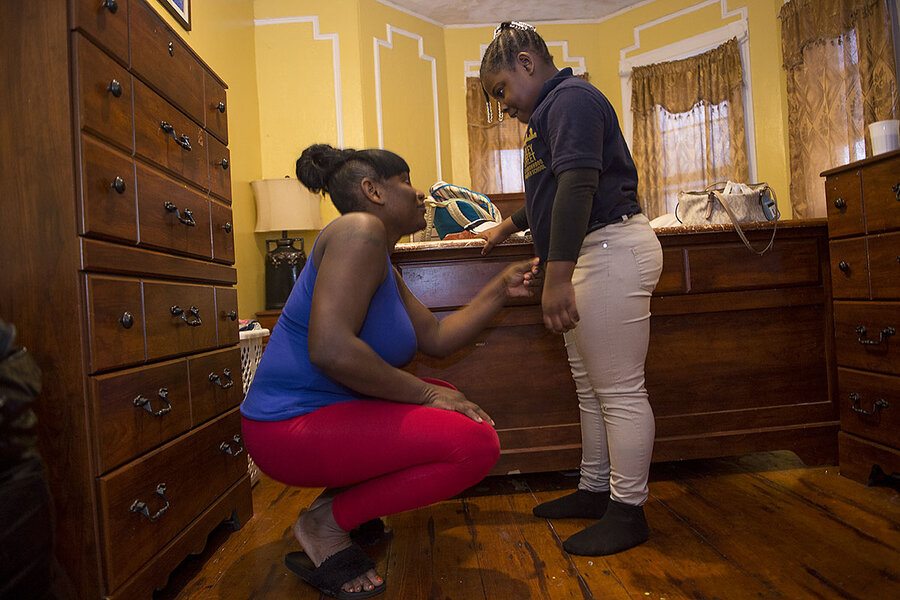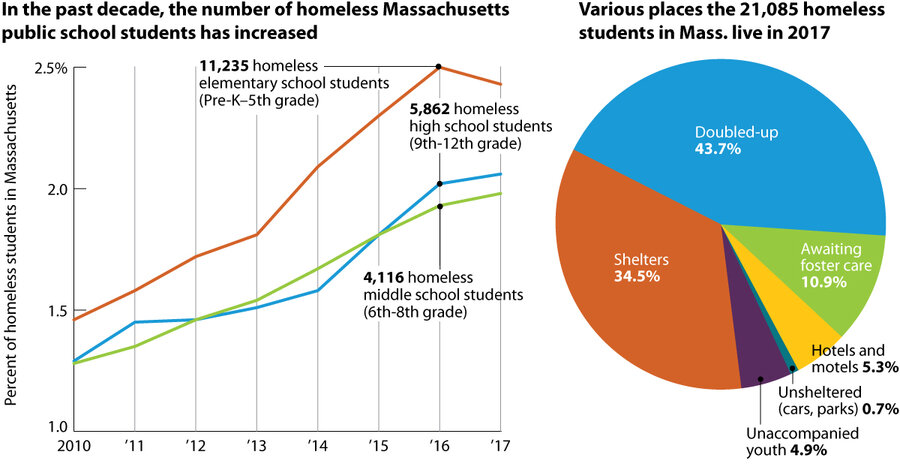In Boston, fight to end homelessness moves from street corner to classroom
Loading...
| Boston
This week, Sashanna Stewart and her second-grade daughter, Saniyah Henry, have something they’ve never had: their own bedrooms.
Ms. Stewart works as a housekeeper for Massachusetts General Hospital, making $21 an hour. But as a single mother, she’s never made enough to afford the $2,500 a month on average for a two-bedroom apartment in Boston. Since Saniyah was born in 2009, they have lived in one room of her mother’s first-floor walkup in Roxbury, a neighborhood south of Boston. Stewart says she signed up for city housing in 2010, but officials told her she made too much money and would likely stay on the waitlist.
“Some people don’t understand that you can still have a job and be homeless,” says Stewart, leaning on the arm of her mother’s couch before the move. “People think you choose to be homeless, but it’s not a choice.”
And so she stayed until one day last year, when Saniyah came home from Dudley Street Neighborhood Charter School with a note in her backpack from Project Hope, a local group that offered the number for a case worker – and eventually a path to the duo's own apartment.
Increasingly, the fight to end homelessness is moving from the street corner to the classroom. Homeless advocates see schools as a natural place to identify families in crisis. Teachers are becoming more attuned to signs of a housing crises, but their jobs as educators leave little time for social work. In the Boston neighborhoods of Dorchester and Roxbury, however, teachers, schools, and community leaders are pooling their resources and collaborating around a specific goal: to stop student homelessness before it happens.
“We’re trying to come at the issue from a different angle,” says Christine Dixon, executive director of Project Hope. “We’re working closely with schools to catch families at risk of homelessness.... It's not asking schools to take this on and be a housing organization, it's just about having the right partners.”
Massachusetts as an epicenter
Stewart is an example of the changing face of homelessness. Rising rents in big cities across the country are pushing families with low-paying jobs into shelters, or more commonly, forcing them to “double-up” in homes of friends or relatives. Massachusetts stands out as an epicenter: after a 245 percent increase since 2006, the Bay State has more than 4,900 homeless families – behind only California and New York. In fact, families represent more than half of the state’s homeless population and more than 2 percent of public school students.
Zooming in on Boston, the problem is even starker. In 2017, more than 3,550 of the 56,000 students in the city's school district are homeless – a sharp spike from 1,500 homeless students in 2009. Advocates say these figures are likely an underestimate because many homeless families are too afraid or embarrassed to identify their situation to school or city officials.
Boston Public Schools (BPS) has moved to address this increase, with Mayor Marty Walsh and Superintendent Tommy Chang designating $1.2 million to aid homeless students in fiscal year 2018. This fall, for the first time, Boston schools have full discretion over a sizable chunk of funding to accommodate the needs of their homeless students, says Brian Marques, director of BPS' Opportunity Youth Department, which oversees homeless education.
Part of the spike is due to better accounting efforts within the state, which is the only one in the country with a “Right to Shelter” law. It guarantees temporary emergency shelter to qualifying families, which incentivizes them to come forward as homeless. And while the large numbers are discouraging, advocates say larger numbers are not necessarily a bad thing: more accurate data allows for adequate federal funding to fight the problem.
Sarah Slautterback, the state's coordinator for homeless education under the McKinney-Vento Homeless Assistance Act, a federal law that provides money to shelters, says her 49 counterparts across the country have witnessed similar increases in homeless families.
“Schools will see families go homeless first,” says Ms. Slautterback, adding that they can do a “great deal” for families, but not everything. “We push pretty hard at seeing what is out there in the community, and see what support we can provide beyond the building.”
Communicating about resources
In Stewart's case, after calling Project Hope, she was put in touch with Paulette Mendes, a case worker for their No Child Goes Homeless Initiative (NCGH). Just as she has done for other parents before and after Stewart, Ms. Mendes offered to sit down, hear Stewart’s story, help her sign up for benefits, provide job training, pay one to two months of missed rent if need be, and devise a plan.
“Families that are referred to me, say, ‘Wow. I’ve been dealing with this issue for a while now, and nobody told me that I can get help,’” says Mendes. “People want to stay in the community, but they don’t know about the different resources, and by the time they learn about them, they are already homeless.”
Stewart, for example, didn’t know that she qualified for food stamps before her phone call with Mendes.
Over the past five school years, 177 families have been referred to NCGH from their three partner schools: Dudley Street Neighborhood Charter School, Dearborn STEM Academy, and Orchard Gardens K-8 Pilot School. Of these families, 90 have been stably housed like Stewart and 42 percent of children in newly stable homes have had notably improved attendance records.
“We realized that this was a neighborhood problem and something we had to address and think about together,” says Project Hope's Ms. Dixon.
Not only does aiding families before they become homeless help a child’s education, but it also saves the state money. Shelters across the state have reached capacity, leading the state to increasingly place families in hotels – which typically costs the state $17,500 per family, according to a 2015 state report.
Comparatively, if a teacher at one of Project Hope’s three partner schools catches a case while the family is still in their home, they can get the family back on track for $800 to $1,000 through their state-funded rental assistance program.
“This program is having a lot of great outcomes, even with the limited resources we have,” says Mendes.
Teachers' role
Lisa Bibuld, director of Student and Family Support at Dudley Street Neighborhood Charter School, and case workers from Project Hope teach educators at Dudley to look for signs of a housing crisis: falling asleep in class, food hoarding, dramatic changes in grades or behavior, or – most importantly – slipping attendance.
“Identifying families is absolutely not just a priority, but it’s really paramount in making sure that a child is getting the services that she needs so she can be successful in school,” says Ms. Bibuld. “When children are not stably housed, when families are not stably housed, there is an inability to be present.… It spirals.”
Massachusetts has more than 21,110 homeless students, a number that’s been increasing for almost a decade. Data shows that these children are more likely to engage in risky behavior, have lower grades and poor attendance records, or dropout of school altogether.
“Homelessness is about poverty, violence, housing – but it's also about education,” says Barbara Duffield, executive director of SchoolHouse Connection and partner on a recent Hidden in Plain Sight Report. “Education is the number one thing to prevent future homelessness. We need to give kids the help they need immediately, but also ensure they won't be homeless in the future.”
Moving forward
Stewart says there were a lot of times in the past three years when she wanted to give up.
“Saniyah would ask, ‘Mommy, when can I get my own room? When can I stop sleeping with you?’ She wants to have friends over but she can’t,” says Stewart. “It makes you feel worthless.”
Because of rising economic inequality and marginalization of low-income communities, teachers today have to be even more attuned to the needs of their students, says Bibuld.
“As educators… we have to be able to notice, see, and understand what we're seeing, in a ways we didn’t use to have to,” she says. “I'm hoping that schools of education where teachers are being trained have an eye to that now.”
As Saniyah walks around her new home on Saturday, each room provides a different kind of excitement. She points out the corner of the living room where she wants to put the Christmas tree, the wall of her bedroom where she will hang Bob Marley posters, and the oven in the kitchen where she plans to bake her favorite cookies.
Stewart laughs at her daughter, but she can't hide her own excitement.
“I have a place to call my own," she says. "Finally.”











